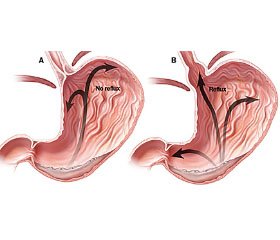Журнал «Здоровье ребенка» 4 (64) 2015
Вернуться к номеру
Stages of diagnosis of pathological gastroesophageal reflux in children
Авторы: Starets E.A , Trukhalska V.V. - Odessa national medical University, (Ukraine, Odessa)
Рубрики: Педиатрия/Неонатология
Разделы: Справочник специалиста
Версия для печати
Introduction. Gastro-esophageal reflux (GER) in children - is the involuntary abandonment of gastric or gastro-intestinal contents into the esophagus. The reason for this is permanent or transient reduction in the tone of the lower esophageal sphincter. Thus, uncharacteristic contents enter in the esophagus causing damage to its mucous membrane. Underestimating the severity of complications of GER and the administration of inappropriate severity of treatment lead to chronic disease at an early age, decreased quality of life and in some cases even to disability.
In infants distinguish between physiological and pathological GER. Pathological GER occurs in infants of 8-10%. This disease can occur in children born prematurely, suffered chronic intrauterine hypoxia , birth asphyxia , natal trauma of the cervical spine , as well as having a family history of diseases of the upper digestive tract and signs of connective tissue dysplasia (such as mitral valve prolapse parents ).
At an early age GER can have bright clinical manifestations. It is characterized by posseting, combined with weight loss, vomiting fountain, mixed with blood or bile, respiratory disorders until the development of sleep apnea and sudden infant death syndrome, and various extra esophageal manifestations (lesions of upper respiratory tract, broncho-pulmonary and cardio-vascular systems).
The diagnosis of GER is based on a set of diagnostic criteria: clinical, endoscopic, histological, radiological, etc. World experience shows that early diagnosis reduces the risk of GER complications at times.
The aim is to develop and study the algorithm - stage diagnosis of pathological GER, depending on the severity and age of the child.
Materials and Methods : it was observed 172 children aged 3 months to 3 years who were in out-and inpatient department in Children's hospital No. 3 and City clinical hospital № 9. Professor A. I. G. Minakova Odessa in the period from June 2012 to February 2014. They came in at the examination and treatment of various somatic diseases. In the study cohort, 64 children ( 37 % , 0.29 - 2.44 , 95% CI ) had complaints related to the gastrointestinal tract .
It was used the following methods of diagnosis : reflux questionnaire , endoscopic examination of the esophagus , molecular genetic study of collagen gene mutations A3 , pH monitoring of the esophagus. Statistical analysis of the data was performed using STATISTICA 7.0 package and Microsoft EXCEL 2010 with the integration of AtteStat 12.5, online calculator SISA (Simple Interactive Statistical Analysis).
Results. The first phase of the study was screened, what allowed to identify the risk of having a child of pathological GER. At this stage parents were asked about the child's condition. They subjectively evaluated the presence of certain symptoms. Each question was provided a score of response, in assessing the results of scores summarized. Interpretation of the indicator was follows: the risk of having a pathological GER was estimated as high in children who had scored more than 9 points, 7 points - the possible presence of pathological GER and less than 6 points - likely no signs of pathological GER.
Depending on the number of points for the evaluation of reflux questionnaire children were divided into 2 groups (the result of less than 7 points and more than 7 points ) . In the next phase of the study , children with the evaluation result reflux questionnaire 7 points or more were sent for further examination, namely , esophageal endoscopy . The third phase of the examination involved molecular genetic analysis of mutations of collagen A3 based on the study the DNA of cells of the oral mucosa .
This study was conducted of 64 patients with the amount of balls under reflux questionnaire of more than 7 , premature babies , as well as having a family history of esophageal disease , mitral valve prolapse parents . Children who underwent molecular genetic testing were divided into 2 groups . The first group included those who were found mutations of collagen A3 in the homozygous state , the second consisted of patients with heterozygous carrier collagen gene mutations A3 .
In the fourth stage , children with a score of more than 7 on the results of reflux- profiles , as well as those who have had symptoms of GERD , fibrogastroscopy questionable results , and patients with mutations in the collagen gene A 3-wire 24 -hour esophageal pH monitoring . Esophageal reflux regarded as pathological if you were standing or lying acid exposure exceeded performance standards for more than 95 % .
Conclusions .
1. Stages of pathological diagnosis of GER allow to set and to confirm the diagnosis with minimal invasive techniques.
2. Using reflux questionnaire helps early diagnosis of pathological GER and GERD in children , a differentiated approach to the use of invasive methods.
3. Genetic testing of children with symptoms of pathological GER , as well as having a family history of esophageal disease , mitral valve prolapse parents , has a high diagnostic value , allowing for early prevention and treatment that can lead to improved quality of life for patients.

